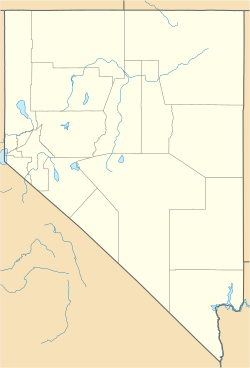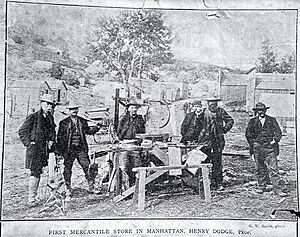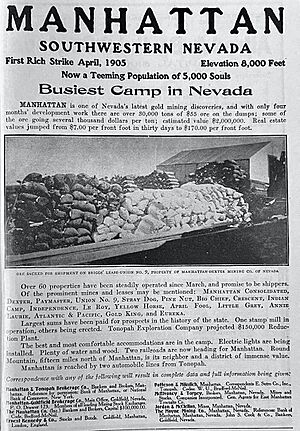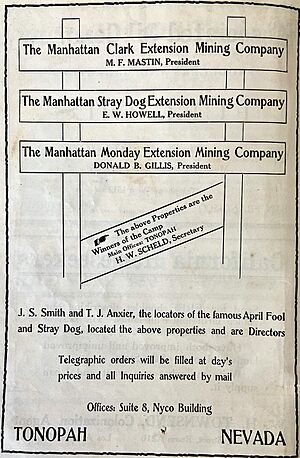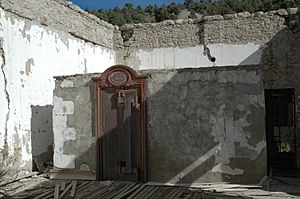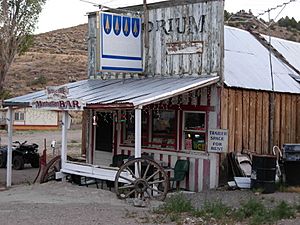Manhattan, Nevada facts for kids
Quick facts for kids
Manhattan, Nevada
|
|
|---|---|
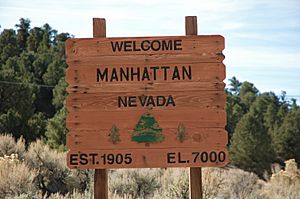
Sign at the east entrance to Manhattan
|
|
| Nickname(s):
Town of New Beginnings
|
|
| Motto(s):
Embracing a better Manhattan
|
|
| Country | United States |
| State | Nevada |
| County | Nye |
| Area | |
| • Total | 0.28 sq mi (0.72 km2) |
| • Land | 0.28 sq mi (0.72 km2) |
| • Water | 0 sq mi (0 km2) |
| Elevation | 7,000 ft (2,000 m) |
| Population
(2010)
|
|
| • Total | 124 |
| • Density | 446/sq mi (172.2/km2) |
| Time zone | UTC-8 (Pacific (PST)) |
| • Summer (DST) | UTC-7 (PDT) |
| ZIP code |
89022
|
| Area code(s) | 775 |
Manhattan is a small town in Nye County, Nevada. It's not officially part of a city, so it's called an unincorporated town. You can find it at the end of Nevada State Route 377, about 50 miles (80 km) north of Tonopah.
Contents
History of Manhattan
Manhattan was first started in 1867. This was during a time when many people came to Nevada looking for silver. Later, in 1871, a person named George Wheeler found the area empty.
Then, in 1905, people rushed back to Manhattan. This time, they were looking for gold! About 4,000 people moved to the area. In 1906, the Nye and Ormsby County Bank was built. It was the only stone building in town.
However, things changed after the big 1906 San Francisco earthquake and a money problem in 1907. The bank had to close.
Around 1904, a woman known as "Mom" Ronzone began selling socks to the miners in Manhattan. This was the start of her business. She later opened Ronzone's department stores in Tonopah and then Las Vegas.
Another gold rush happened in 1909. Mining continued in Manhattan until the late 1940s. Large mining companies worked here from the 1970s to the 1990s. Recently, however, mining has slowed down a lot.
Understanding the Local Landscape
Manhattan is located in the Big Smoky Valley. This valley is like many others in Nevada's desert. It has tall mountain ranges running north to south on its sides. To the south, you'll find Lone Mountain. The Toquima Mountains are to the east, and the Toiyabe Mountains are to the west.
The bottom of the valley is mostly made of alluvial fans. These are fan-shaped piles of small, rough gravel. These gravels come from the nearby mountains.
The rocks in this area are very old. Some are from the Cambrian period, which was hundreds of millions of years ago! These rocks include limestone, slate, schist, and quartzite. They were once covered by other rocks, but now you can see them in the mountain ranges.
There are also many igneous rocks in the Big Smoky Valley. These rocks formed from cooled lava. You can see them in the mountains around the valley. Large granite rocks are also found here, especially in the Toquima Range and Lone Mountain.
Long ago, during the late Pleistocene Ice Age, two large lakes filled parts of the Big Smoky Valley. These lakes were called Lake Toiyabe and Lake Tonopah. Today, you can still see signs of these old lakes, like gravel beaches. The areas where the lakes once were are now flat, dry areas.
Manhattan Gulch and Gold
About 16 million years ago, there was a lot of volcanic activity in the mountains near Manhattan. This activity helped create the gold found here. Hot liquids deep underground carried gold from melted rock to other rocks.
Over a very long time, the top layers of rock in Manhattan wore away. This is why the hills in the area are low and rounded. As the rocks eroded, the gold they contained was washed down into Manhattan Gulch. It settled there in the gravel.
Manhattan Gulch is about 300 feet (91 m) wide. It slopes gently to the east. The sides of the gulch are quite steep. The gravel in the gulch can be from 10 to 100 feet (3 to 30 m) deep. On average, it's about 30 feet (9 m) deep. Most of the gravel pieces are larger than 1 inch (2.5 cm). The bottom of the gulch is mostly made of schist and shale rock.
The elevation in Manhattan Gulch ranges from about 5,800 feet (1,768 m) above sea level at the west end to over 7,000 feet (2,134 m) near the town of Manhattan.
Plants of Manhattan Gulch
In the spring of 2009, scientists studied the plants in Manhattan Gulch. In the lower parts of the gulch, below 6,600 feet (2,012 m), shrubs are the most common plants. They make up about 80 percent of all the plants. Grasses are next, making up about 15 percent. Then there are various forbs, which are small flowering plants.
Common shrubs you might see include black sage (Artemisia nova), green rabbitbrush (Chrysothamnus viscidiflorus), and bud sage (Artemisia spinescens). Some grasses found here are galleta (Hilaria jamesii) and Indian ricegrass (Acnatherum hymenoides).
Further west, closer to the town of Manhattan, trees become more common. You'll often see Juniperus osteosperma (Juniper trees) and Pinus monophylla (Pinyon pine trees).
Manhattan Today
As of 2005, about 124 people lived in Manhattan. The town has two bars: The Miner's Saloon and The Manhattan Bar and Motel.
About 10 miles (16 km) north of Manhattan, along State Route 376, people are still doing a small amount of gold mining. They use a method called placer gold mining, which involves sifting gold from gravel.
Climate in Manhattan
Manhattan has a semi-arid climate. This means it's quite dry. Summers are short and warm, while winters are long and cold. It doesn't have a specific wet or dry season; rain and snow are spread out throughout the year.
Because Manhattan is high up in the mountains (about 7,000 feet or 2,134 m), summer temperatures rarely go above 90°F (32°C). The high elevation also means there's a big difference between daytime and nighttime temperatures. Even in summer, nights are cool. It's rare, but temperatures can drop below freezing in any month of the year. Winters are long and can be very cold.
| Climate data for Manhattan, Nevada (Elevation 7,000ft) | |||||||||||||
|---|---|---|---|---|---|---|---|---|---|---|---|---|---|
| Month | Jan | Feb | Mar | Apr | May | Jun | Jul | Aug | Sep | Oct | Nov | Dec | Year |
| Record high °F (°C) | 63 (17) |
64 (18) |
70 (21) |
78 (26) |
86 (30) |
93 (34) |
96 (36) |
95 (35) |
92 (33) |
80 (27) |
70 (21) |
60 (16) |
96 (36) |
| Mean daily maximum °F (°C) | 37.5 (3.1) |
40.1 (4.5) |
46.5 (8.1) |
53.6 (12.0) |
60.9 (16.1) |
71.2 (21.8) |
80.1 (26.7) |
79.8 (26.6) |
69.9 (21.1) |
59.0 (15.0) |
44.5 (6.9) |
37.4 (3.0) |
56.3 (13.5) |
| Mean daily minimum °F (°C) | 13.8 (−10.1) |
16.1 (−8.8) |
21.3 (−5.9) |
25.6 (−3.6) |
31.8 (−0.1) |
39.3 (4.1) |
47.4 (8.6) |
47.3 (8.5) |
38.5 (3.6) |
29.2 (−1.6) |
20.2 (−6.6) |
13.6 (−10.2) |
28.4 (−2.0) |
| Record low °F (°C) | −15 (−26) |
−20 (−29) |
−4 (−20) |
0 (−18) |
10 (−12) |
17 (−8) |
20 (−7) |
27 (−3) |
15 (−9) |
−3 (−19) |
−8 (−22) |
−30 (−34) |
−30 (−34) |
| Average precipitation inches (mm) | 0.99 (25) |
0.93 (24) |
1.12 (28) |
0.69 (18) |
0.97 (25) |
0.56 (14) |
0.94 (24) |
0.60 (15) |
0.79 (20) |
0.58 (15) |
0.73 (19) |
0.69 (18) |
9.89 (251) |
| Source: The Western Regional Climate Center | |||||||||||||
See also
 In Spanish: Manhattan (Nevada) para niños
In Spanish: Manhattan (Nevada) para niños


